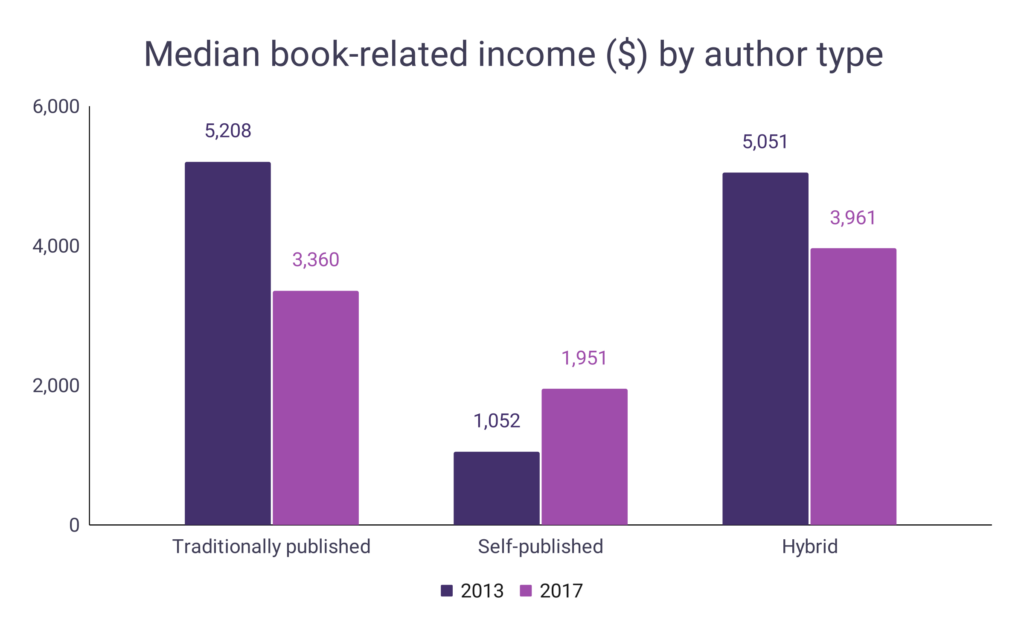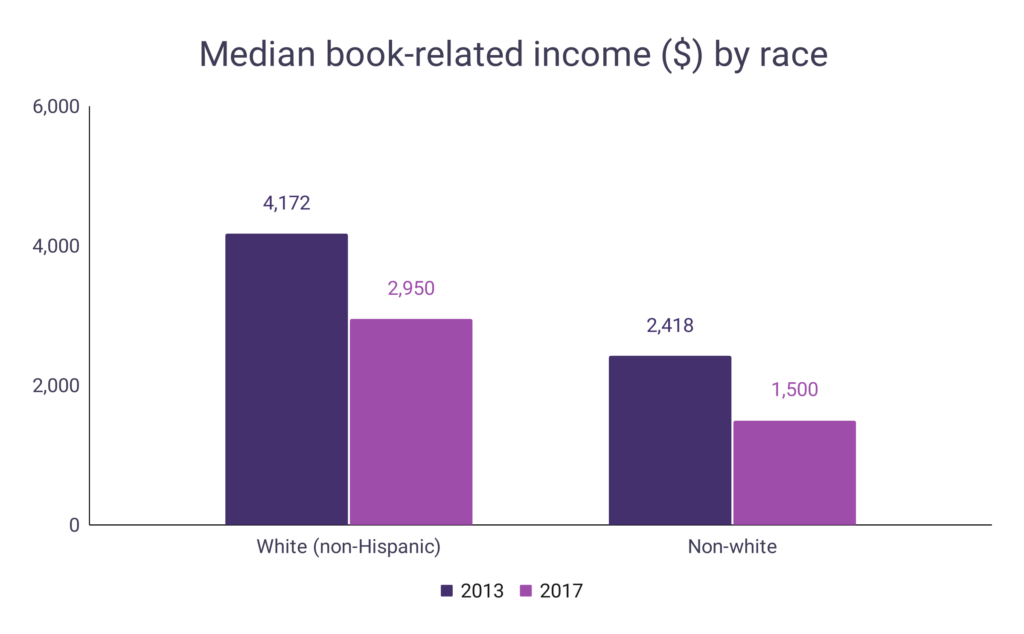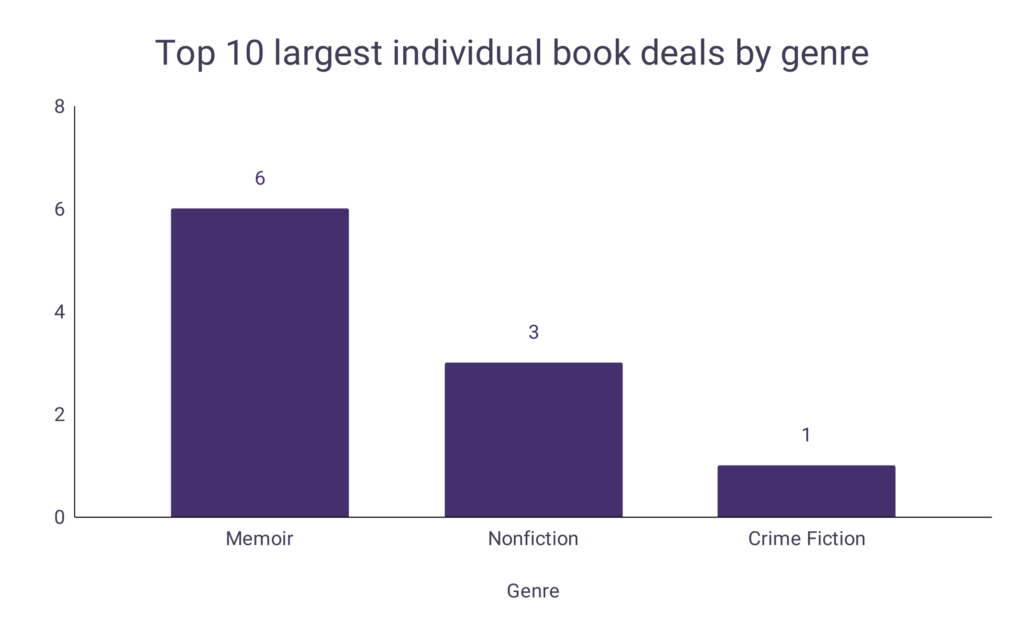Throughout the publishing industry, there exists a great variation in the amount of money earned by authors and their net worth across different genres. In addition to an author’s perceived level of ability, the manner by which they choose to publish, preceding reputation and personal background can all play a consequential part in the amount of income they generate.
- Book advances often start at $5,000 from major publishing houses.
- Advances from independent publishers are slightly lower, often starting at $1,000.
- Authors who work alongside traditional publishers can earn royalties once an advance has been repaid (earning out).
- Traditional paperback royalties usually range from 5% to 7.5%, whereas hardback royalties often range from 10% to 15%.
- By looking to self-publish, authors can immediately earn up to 70% in royalties.
- If an author’s work is selected, TV/movie option deals can also be around $15,000 for a three-year deal.
- Despite these rates, 54% of full-time authors earned less than $12,488 annually from their writing as of 2017.
- 23% of full-time authors received zero income from their books.
- Hybrid authors (both traditionally & self-published) generated the highest median book-related income at $3,961.
- Trade fiction authors generated the highest median book-related income at $4,912.
How much do authors make per book?
In traditional publishing, authors will receive royalty payments from each sold copy once the book advances have been repaid. The royalty is usually calculated based on the book’s net price after deducting publishing and distribution costs.
When calculating the author’s royalty earnings, multiple factors affect the royalty: the format of the sold copy, the type of print, and the type of publishing. Along with these factors, the author’s previous success and the publishers’ overall confidence in the book’s selling potential.
- When it comes to traditional publishing, authors can expect between a 5% and 15% royalty rate, depending on the type of print.
- Paperback and mass-market paperback royalties are the lowest, usually ranging between 5% and 7.5%.
- For hardcovers, royalties are the highest, mostly in the 10% to 15% range.
- If an author sells 5,000 copies of their book at a $10 net price, they can expect to earn between $2,500 and $7,500 in royalty payments after the advance has been paid off.
- This figure gets much higher if an author goes with self-publishing, and for 5,000 copies sold at a $10 net price, they can expect to earn between $20,000 and $35,000.
- Authors who self-publish can expect to earn between 2.6 and 14 times more than those who go with traditional publishing, advances excluded.
| Traditional publishing | Self-publishing | |
| Royalty | 5% – 15% | 40% – 70% |
| Book price (net) | $10 | $10 |
| Copies sold | 5000 | 5000 |
| Total income | $2,500 – $7,500 | $20,000 – $35,000 |

- In order to earn $100,000 from book-selling, authors who decide to publish their book with traditional publishers need to sell between 66,667 and 200,000 copies of their books.
- The final count depends on royalties and the assumed net price of the book standing at $10.
- With the same net book selling price, authors who go with self-publishing must sell between 14,286 and 25,000 copies of their books to earn $100,000 from book sales.
| Traditional publishing | Self-publishing | |
| Lowest royalty | 5% | 40% |
| Highest royalty | 15% | 70% |
| Book price (net) | $10 | $10 |
| Required copies sold to earn $100,000 (lowest royalty) | 200,000 | 25,000 |
| Required copies sold to earn $100,000 (highest royalty) | 66,667 | 14,286 |

Earnings from major publishers
- For large publishing houses, advances can start at $5,000 for first-time authors, increasing to a five-figure sum depending on reputation, number of books in the deal, etc.
- Deals from the Big 5 offer authors an even greater opportunity to receive a five-figure advance or more.
- Once advances have been met, publishers pay out royalties on additional book sales, often using standard pre-agreed rates.
- The sale of a manuscript to a major/Big 5 publisher is usually overseen by a literary agent who will generally look to keep 15% of the deal’s total earnings.
- Many authors aspire to have a deal with a major/Big 5 publisher and will dedicate time to signing with an agent who can help them achieve this.
Earnings from independent publishers
- Independent publishers may accept submissions without the involvement of agents.
- Due to their smaller size and decreased governance, they can be more likely to take a risk on alternative/niche book topics.
- Indie publishers generally look to offer advances from $3,000 and upwards.
- As these advances are of a lower value, they may offer authors a higher royalty revenue percentage that kicks in once the advance has been matched.
- If an independent publisher wants to make a book their lead title, they may offer a bigger advance than a major publisher, due to its increased importance.
Earnings from self-publishing
- For authors who do not have a deal with a publisher, self-publishing is an alternative route-to-market.
- Self-published authors fully own their work and as such, it is the author’s responsibility to perform price-setting, marketing and sales.
- Online activities are key, with ebooks making up the majority of self-published sales.
- Self-published authors often look to use services by companies such as Amazon in order to print-on-demand.
- Furthermore, by self-publishing, an author is able to receive a larger percentage of each book sale.
Median book-related income
Although there are authors that are able to make a living from writing alone, many authors earn less than minimum wage and work multiple jobs to supplement their income. Even if an author is talented, the odds of a manuscript being published by a traditional publishing house is between 1% – 2%.
By author type
(both full-time and part-time authors)
- As of 2017, hybrid authors (both traditionally & self-published) have the highest median book-related income at $3,961.
- This is a drop of 21.58% when compared to 2013.
- Traditionally published authors have the second highest median book-related income at $3,360.
- This is a drop of 35.48% when compared to 2013.
- Self-published authors have the lowest median book-related income at $1,951.
- However, it showed an increase of 85.46% since 2013, the only author type to increase over the period.
| Author type | 2013 | 2017 | Change |
| Traditionally published | $5,208 | $3,360 | – 35.48% |
| Self-published | $1,052 | $1,951 | + 85.46% |
| Hybrid | $5,051 | $3,961 | – 21.58% |
A graph to show median book-related incomes by author type is given below:

By genre
- As of 2017, authors that specialize in trade fiction generate the highest median book-related income at $4,912.
- However, this is a decrease of 4.79% since 2013.
- Commercial Nonfiction authors generate the second highest median book-related income at $2,950.
- This is a drop of 36.99% since 2013.
- Literary fiction authors generate the lowest median book-related income at $1,500.
- This is a drop of 46.04% since 2013.
| Genre | 2013 | 2017 | Change |
| Literary fiction | $2,780 | $1,500 | – 46.04% |
| Commercial nonfiction | $4,682 | $2,950 | – 36.99% |
| Trade fiction | $5,159 | $4,912 | – 4.79% |
A graph to show median book-related incomes by book genre is given below:

By race
- As of 2017, white (non-Hispanic) authors generated a median book-related income of $2,950.
- This is a drop of 29.29% since 2013.
- Non-white authors generated a median book-related income of $1,500.
- This is a drop of 37.97% since 2013.
- Showing a disparity when it comes to diversity, the median book-related income for white (non-Hispanic) authors was almost double that of non-white authors.
| Race | 2013 | 2017 | Change |
| White (non-Hispanic) | $4,172 | $2,950 | – 29.29% |
| Non-white | $2,418 | $1,500 | – 37.97% |
A graph to show median book-related incomes by race is given below:

Largest book deals for individual books
- The largest individual book deals were $15 million for both Bill Clinton’s “My Life” (2004) and for Britney Spears’ upcoming memoir.
- Memoirs make up six of the top ten largest individual book deals of all time.
- Three of the top ten largest individual book deals were in the Nonfiction genre.
- One of the top ten largest individual book deals was in the Crime fiction genre.
- From the largest individual book deals, only Tom Wolfe and J. K. Rowling are primarily known as authors.
| Year | Title | Author | Deal size | Genre |
| 2004 | My Life | Bill Clinton | $15 million | Memoir |
| N/A | N/A | Britney Spears | $15 million | Memoir |
| 2014 | Hard Choices | Hillary Clinton | $14 million | Memoir |
| 2016 | Born to Run | Bruce Springsteen | $10 million | Memoir |
| 2016 | The Girl with the Lower Back Tattoo | Amy Schumer | $9 million | Memoir |
| 1994 | Crossing the Threshold of Hope | Pope John Paul II | $8.5 million | Nonfiction |
| 2010 | Life | Keith Richards | $7.3 million | Memoir |
| 2008 | Back to Blood | Tom Wolfe | $7 million | Nonfiction |
| N/A | The Maramon Convention | Abraham Verghese | $5 million | Nonfiction |
| 2012 | The Casual Vacancy | J. K. Rowling | $2-8 million | Crime fiction |
A graph is given below to show the largest individual book deals by genre:

A graph is given below to show the largest individual book deals by author profession:

How much do authors make FAQ
What are book advances?
- A book advance is a figure paid to an author by a publisher to cover expenses while the book is written.
- The figure is an estimate of its future earnings and conveys confidence in the author from the publishing house.
- Book advances typically range from low four-figure sums up to seven-figure sums.
- Advances are usually paid by the Big 5 publishers, major publishers and independent publishers.
- Furthermore, authors have to pay tax on book advance earnings.
What are book royalties?
- Royalties are paid to authors by publishers in order to publish their books.
- The royalty rate is a percentage of the value of book sales made. Although negotiable, many publishers have standard rates which they utilize for most authors.
- For publishing houses, royalties are usually paid out on any profits that exceed the value of the advance. The book format affects the rate:
- Paperback royalties: 5% to 7.5%
- Hardback royalties: 10% to 15%
- Higher royalties are sometimes offered to authors as an alternative to paying advances.
- Self-published authors can immediately start earning royalties at a higher rate as they do not receive an advance.
What are foreign book rights?
- An author or a publisher can submit publications to a foreign rights agent to represent titles in different languages.
- The foreign rights agent looks to offer publications to foreign publishers who may be interested in their titles.
- Authors are paid by foreign publishers for each language/region the book is sold to.
- This can range from $1,500 per title and language/region, upwards to six-figures in rare cases.
What are book television/movie rights?
- For a book to be adapted for a TV series or movie, a producer obtains story rights from the author for a limited time to determine if the adaptation will be worthwhile.
- As part of this option contract agreement, the author is given money in exchange for the rights.
- If the time period expires, rights can be re-sold. In some cases, this allows authors to profit multiple times from the same title.
- Although option deals can vary, a standard contract could be around $15,000 for a three-year deal.
- The contract itself is often negotiated by publishers/agents directly, who could look to charge between 15% to 20% for the service.

